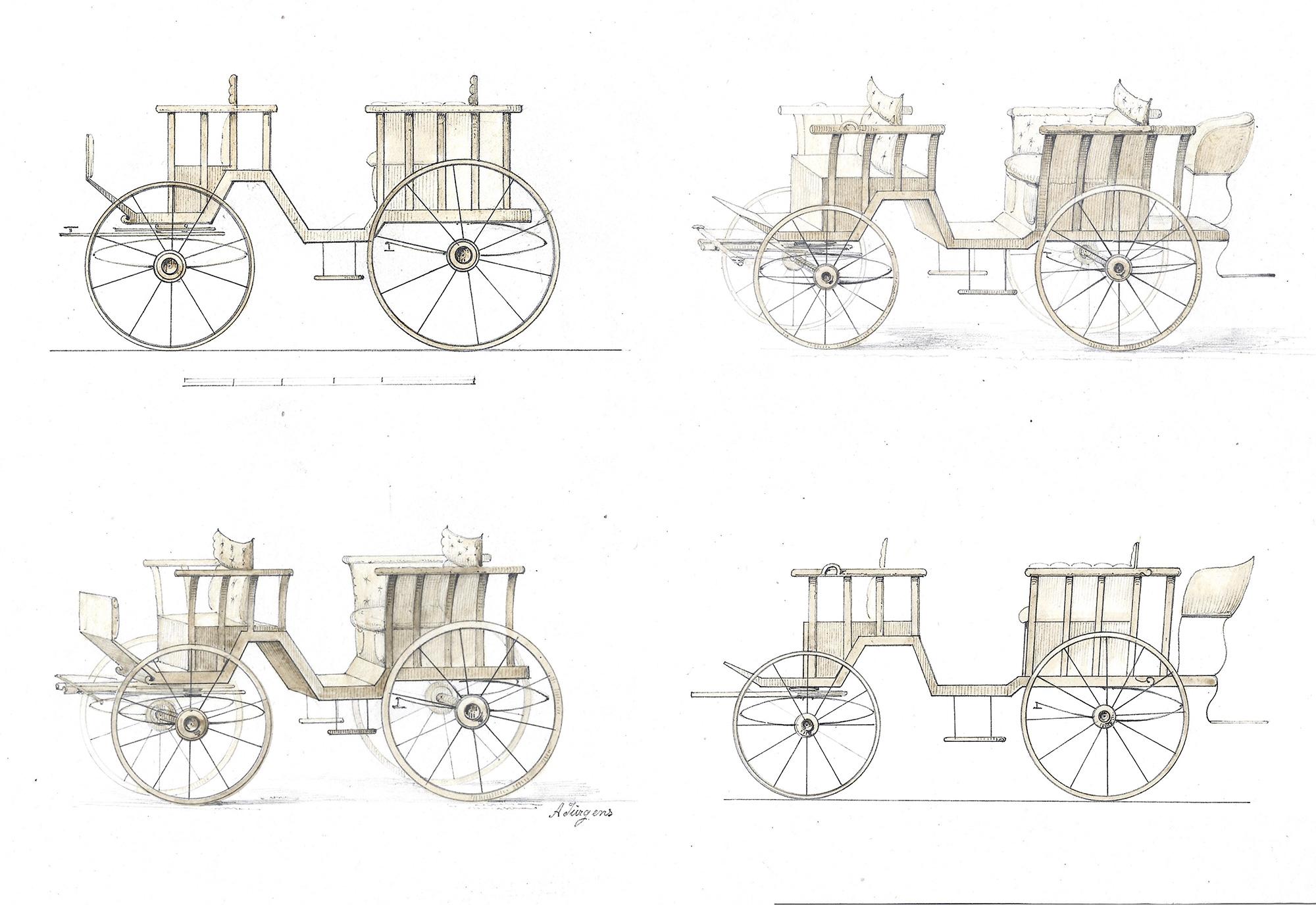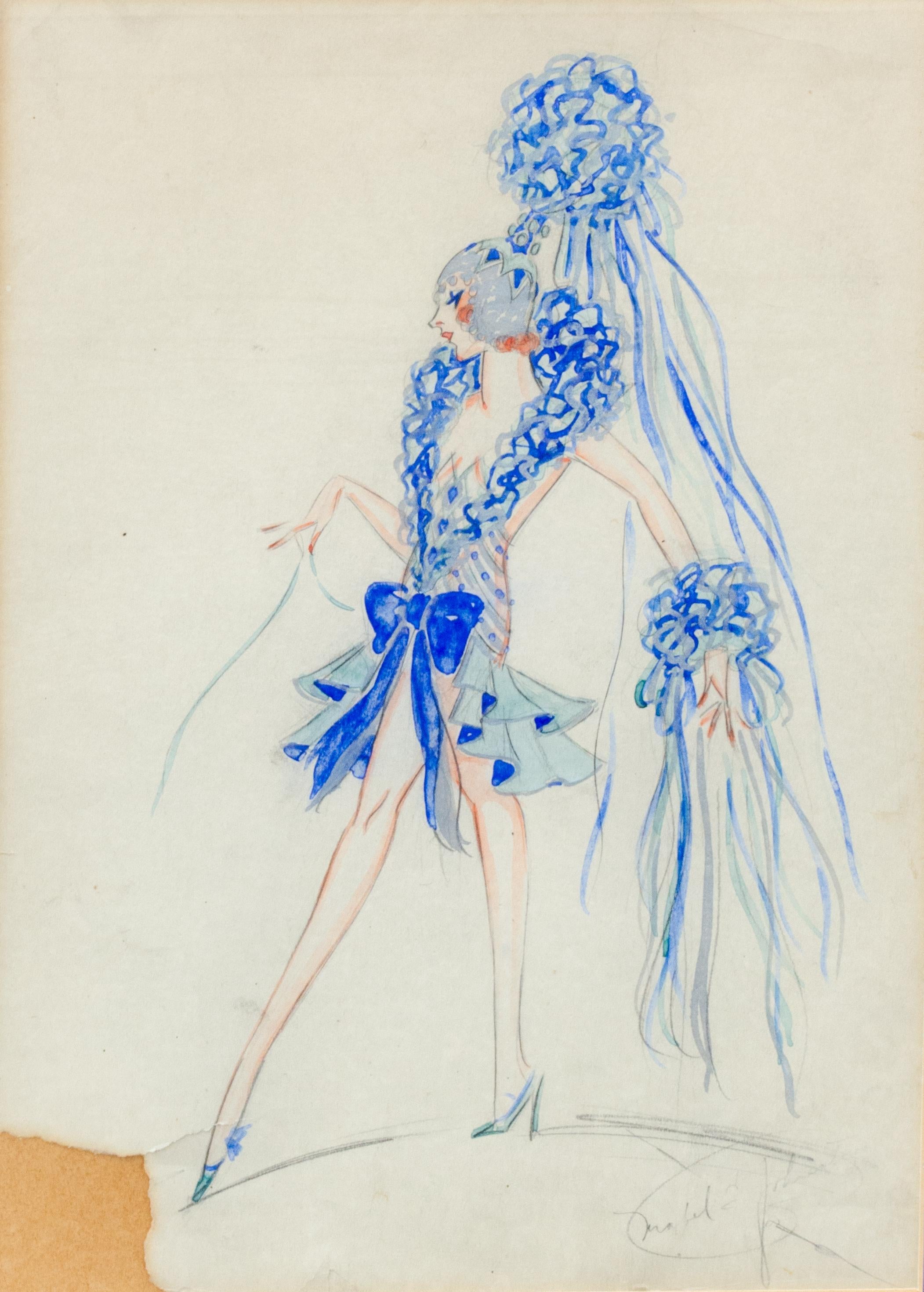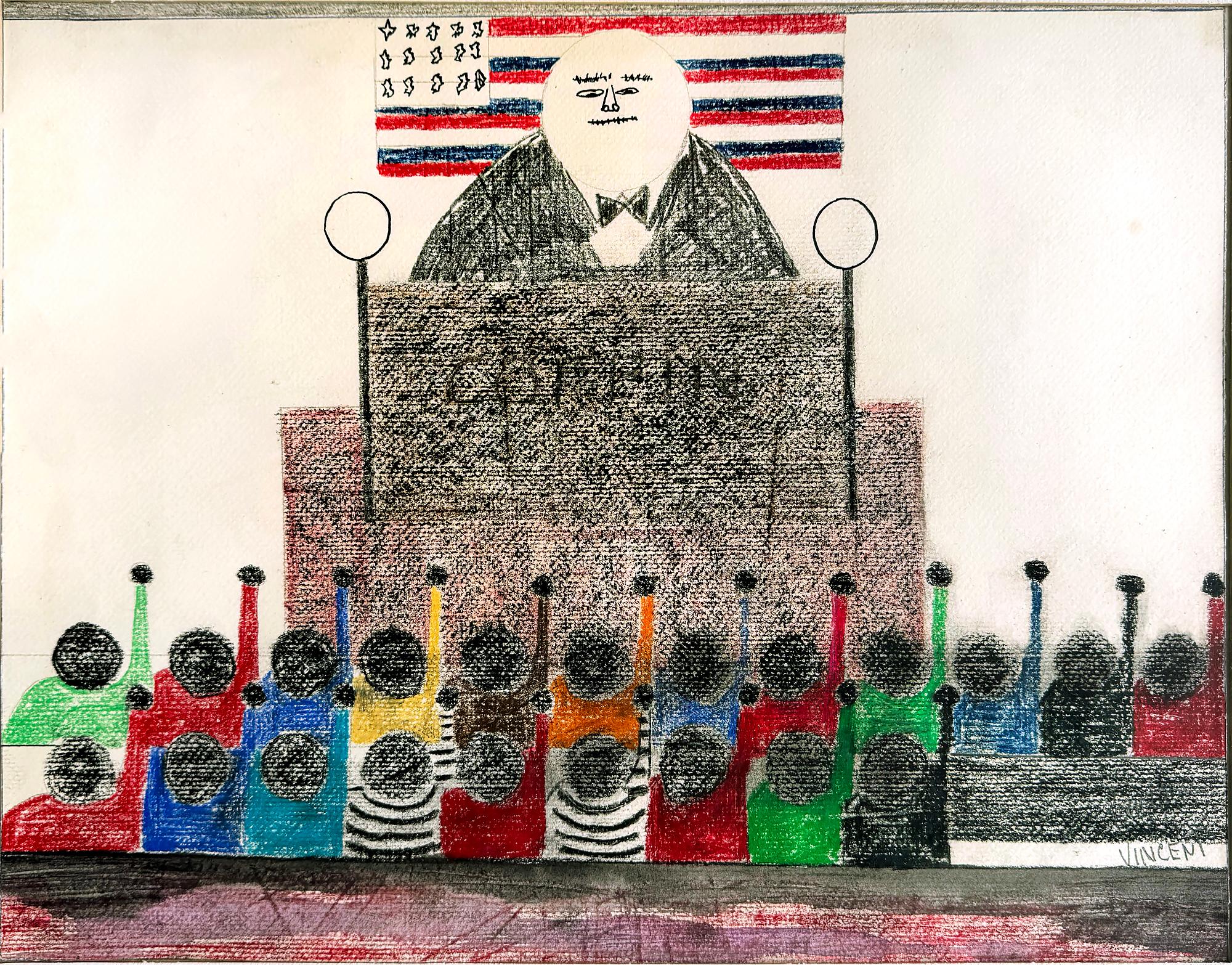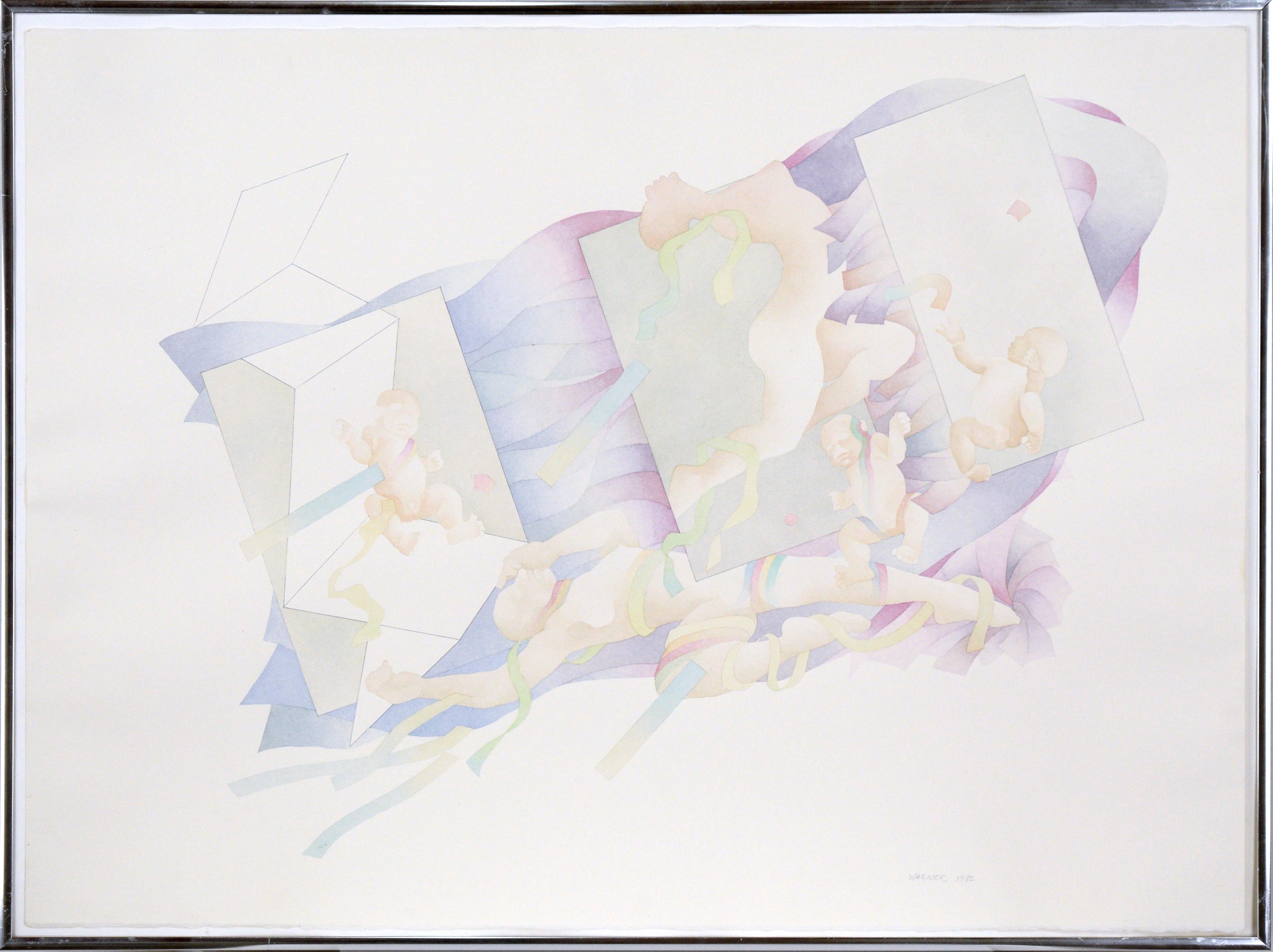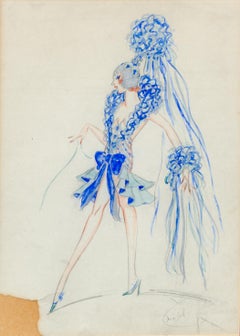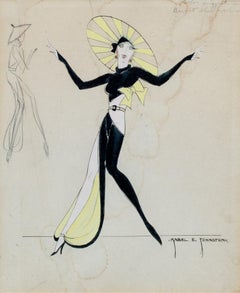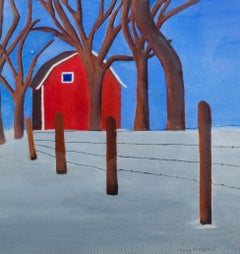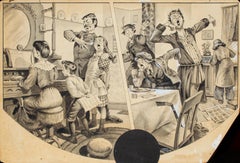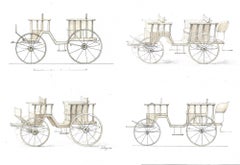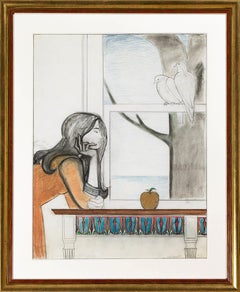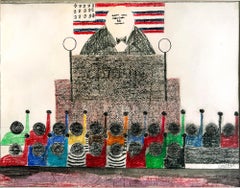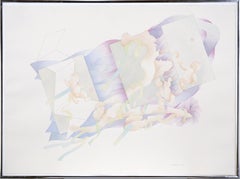Items Similar to Jazz Age Dancer Illustration by Broadway Designer Mabel E. Johnston
Want more images or videos?
Request additional images or videos from the seller
1 of 6
Mabel E. JohnstonJazz Age Dancer Illustration by Broadway Designer Mabel E. Johnstonc. 1920s
c. 1920s
About the Item
Mabel E. Johnston
Untitled, c. 1930s
Watercolor and pencil on paper
Sight: 12 1/2 x 10 1/2 in.
Framed: 21 1/8 x 17 1/4 x 1/2 in.
Signed lower right: Mabel E. Johnston
The first tidbit I found comes from the Forty-Sixth Annual Report of the Pennsylvania Museum and School of Industrial Art, noting that a Mabel Emma Johnston graduated with a diploma from the Department of Industrial Art at the Pennsylvania Museum and School of Industrial Art in 1922. She was awarded two prizes for costume design in the competition “Good Taste in Dress for Young Girls.”
Less than a year after her graduation, Johnston got her first job for Broadway designing costumes for the 1923 musical comedy Sun Showers. Johnston worked fairly steadily on Broadway throughout the 1920s, designing mostly for musical comedies and revues.
Johnston also did designs for The Merry Malones, which was written and produced by, and starred George M. Cohan in 1927. In 1940, Johnston was elected vice-president of the Theatrical Costume Designers Union, a division of the United Scenic Artists.
Despite a prolific output during the 1920s, Johnston all but disappeared from Broadway theater after 1929. Her final Broadway credit is from the 1941 play My Fair Ladies where she served as costume supervisor, but her last Broadway job before that was in 1933. She collaborated on costumes for Olga Baklanova and Bela Lugosi, stars of the musical Murder at the Vanities, in what was also her last design credit.
Biographical information sourced from the Museum of the City of New York
- Creator:Mabel E. Johnston (American)
- Creation Year:c. 1920s
- Dimensions:Height: 21.125 in (53.66 cm)Width: 17.25 in (43.82 cm)Depth: 0.5 in (1.27 cm)
- Medium:
- Movement & Style:
- Period:
- Condition:Not examined outside of the frame.
- Gallery Location:New York, NY
- Reference Number:1stDibs: LU2211212552472
About the Seller
5.0
Vetted Professional Seller
Every seller passes strict standards for authenticity and reliability
1stDibs seller since 2022
71 sales on 1stDibs
Typical response time: 7 hours
- ShippingRetrieving quote...Shipping from: New York, NY
- Return Policy
Authenticity Guarantee
In the unlikely event there’s an issue with an item’s authenticity, contact us within 1 year for a full refund. DetailsMoney-Back Guarantee
If your item is not as described, is damaged in transit, or does not arrive, contact us within 7 days for a full refund. Details24-Hour Cancellation
You have a 24-hour grace period in which to reconsider your purchase, with no questions asked.Vetted Professional Sellers
Our world-class sellers must adhere to strict standards for service and quality, maintaining the integrity of our listings.Price-Match Guarantee
If you find that a seller listed the same item for a lower price elsewhere, we’ll match it.Trusted Global Delivery
Our best-in-class carrier network provides specialized shipping options worldwide, including custom delivery.More From This Seller
View AllBroadway Costume Illustration by Designer Mabel E. Johnston
Located in New York, NY
Mabel E. Johnston
Untitled, c. 1920s
Watercolor and pencil on paper
Sight: 18 x 12 1/2 in.
Framed: 39 x 21 1/4 x 1/2 in.
Signed lower right: Mabel E. Johnston
The first tidbit I fou...
Category
1920s American Modern Figurative Drawings and Watercolors
Materials
Paper, Watercolor, Pencil
Art Deco Costume Illustration by Broadway Designer Mabel E. Johnston
Located in New York, NY
Mabel E. Johnston
Untitled, c. 1920s
Watercolor and pencil on paper
Sight: 12 1/2 x 10 1/2 in.
Framed: 21 1/8 x 17 1/4 x 1/2 in.
Signed lower right: Mabel E. Johnston
The first tidb...
Category
1920s American Modern Figurative Drawings and Watercolors
Materials
Paper, Watercolor, Pencil
Snow-Covered Red Barn Watercolor by Kathleen Fitzgerald
Located in New York, NY
Kathleen Fitzgerald
Untitled (Red Barn), c. Later 20th century
Watercolor on paper
Sight: 11 1/4 x 10 3/4 in.
Framed: 16 x 15 x 3/4 in.
Signed lower right: Kathy Fitzgerald
"I am Ka...
Category
Late 20th Century American Modern Figurative Drawings and Watercolors
Materials
Paper, Watercolor
Rockwellian Style Watercolor by WW2 Illustrator Carol Johnson
Located in New York, NY
Carol Johnson (American, c. 1917-2003)
Untitled (American Family), c. 1950
Watercolor and paper mounted to board
13 5/8 x 23 inches
Signed lower right: C...
Category
1950s American Modern Figurative Drawings and Watercolors
Materials
Paper, Mixed Media, Watercolor, Board
Charming Watercolor of a Southern Home
Located in New York, NY
Unknown Artist
Untitled (Country Home), 20th Century
Watercolor and ink on paper
21 x 29 in.
Framed: 28 1/4 x 36 1/16 x 3/4 in.
Category
20th Century American Modern Figurative Drawings and Watercolors
Materials
Paper, Ink, Watercolor
Unknown American Modernism School - Drawing of a Kitchen Interior
Located in New York, NY
Unknown American Modernism School
Untitled (Kitchen), c. 1930
Pencil on paper
Sight size: 10 x 12 in.
Framed: 16 3/4 x 20 3/4 in.
Category
1930s American Modern Figurative Drawings and Watercolors
Materials
Paper, Pencil
You May Also Like
Kutschen (carriages); Group of four designs for hansom cabs.
By Alfred Juergens
Located in Middletown, NY
Four pencil drawings, each with hand coloring in watercolor, each 6 3/4 x 10 inches (sheet) (172 x 254 mm), full margins. Each with inscriptions and notations by the artist in the up...
Category
Mid-20th Century American Modern Still-life Drawings and Watercolors
Materials
Handmade Paper, Watercolor, Pencil
Final Study for Atalanta, Girl with Apple
By Will Barnet
Located in Greenwich, CT
Will Barnet is one of America's best loved and known artists of the Post War era. He is highly distinctive for his figurative and narrative work and in some ways he is the Edgar All...
Category
1970s American Modern Figurative Drawings and Watercolors
Materials
Watercolor, Vellum, Color Pencil, Graphite
Black Panther Trials - Civil Rights Movement Police Violence African American
Located in Miami, FL
The Black Panther Trials - In this historically significant work, African American Artist Vicent D. Smith functions as an Art Journalist/ Court Reporter as much as a
Artist. Here, he depicts, in complete unity, 21 Black Panther Protestors raising their fist of defiance at the White Judge. Smith's composition is about utter simplicity, where the Black Panther Protestors are symmetrically lined up in a confrontation with a Judge whose size is exaggerated in scale. Set against a stylized American Flag, the supercilious Judge gazes down as the protesters as their fists thrust up. Signed Vincent lower right. Titled Panter 21. Original metal frame. Tape on upper left edge of frame. 255 . Panther 21. Framed under plexi.
_____________________________
From Wikipedia
In 1969-1971 there was a series of criminal prosecutions in New Haven, Connecticut, against various members and associates of the Black Panther Party.[1] The charges ranged from criminal conspiracy to first-degree murder. All charges stemmed from the murder of 19-year-old Alex Rackley in the early hours of May 21, 1969. The trials became a rallying-point for the American Left, and marked a decline in public support, even among the black community, for the Black Panther Party
On May 17, 1969, members of the Black Panther Party kidnapped fellow Panther Alex Rackley, who had fallen under suspicion of informing for the FBI. He was held captive at the New Haven Panther headquarters on Orchard Street, where he was tortured and interrogated until he confessed. His interrogation was tape recorded by the Panthers.[2] During that time, national party chairman Bobby Seale visited New Haven and spoke on the campus of Yale University for the Yale Black Ensemble Theater Company.[3] The prosecution alleged, but Seale denied, that after his speech, Seale briefly stopped by the headquarters where Rackley was being held captive and ordered that Rackley be executed. Early in the morning of May 21, three Panthers – Warren Kimbro, Lonnie McLucas, and George Sams, one of the Panthers who had come East from California to investigate the police infiltration of the New York Panther chapter, drove Rackley to the nearby town of Middlefield, Connecticut. Kimbro shot Rackley once in the head and McLucas shot him once in the chest. They dumped his corpse in a swamp, where it was discovered the next day. New Haven police immediately arrested eight New Haven area Black Panthers. Sams and two other Panthers from California were captured later.
Sams and Kimbro confessed to the murder, and agreed to testify against McLucas in exchange for a reduction in sentence. Sams also implicated Seale in the killing, telling his interrogators that while visiting the Panther headquarters on the night of his speech, Seale had directly ordered him to murder Rackley. In all, nine defendants were indicted on charges related to the case. In the heated political rhetoric of the day, these defendants were referred to as the "New Haven Nine", a deliberate allusion to other cause-celebre defendants like the "Chicago Seven".
The first trial was that of Lonnie McLucas, the only person who physically took part in the killing who refused to plead guilty. In fact, McLucas had confessed to shooting Rackley, but nonetheless chose to go to trial.
Jury selection began in May 1970. The case and trial were already a national cause célèbre among critics of the Nixon administration, and especially among those hostile to the actions of the FBI. Under the Bureau's then-secret "Counter-Intelligence Program" (COINTELPRO), FBI director J. Edgar Hoover had ordered his agents to disrupt, discredit, or otherwise neutralize radical groups like the Panthers. Hostility between groups organizing political dissent and the Bureau was, by the time of the trials, at a fever pitch. Hostility from the left was also directed at the two Panthers cooperating with the prosecutors. Sams in particular was accused of being an informant, and lying to implicate Seale for personal benefit.
In the days leading up to a rally on May Day 1970, thousands of supporters of the Panthers arrived in New Haven individually and in organized groups. They were housed and fed by community organizations and by sympathetic Yale students in their dormitory rooms. The Yale college dining halls provided basic meals for everyone. Protesters met daily en masse on the New Haven Green across the street from the Courthouse (and one hundred yards from Yale's main gate). On May Day there was a rally on the Green, featuring speakers including Jean Genet, Abbie Hoffman, Jerry Rubin, and John Froines (an assistant professor of chemistry at the University of Oregon). Teach-ins and other events were also held in the colleges themselves.
Towards midnight on May 1, two bombs exploded in Yale's Ingalls Rink, where a concert was being held in conjunction with the protests.[4] Although the rink was damaged, no one was injured, and no culprit was identified.[4]
Yale chaplain William Sloane Coffin stated, "All of us conspired to bring on this tragedy by law enforcement agencies by their illegal acts against the Panthers, and the rest of us by our immoral silence in front of these acts," while Yale President Kingman Brewster Jr. issued the statement, "I personally want to say that I'm appalled and ashamed that things should have come to such a pass that I am skeptical of the ability of a Black revolutionary to receive a fair trial anywhere in the U.S." Brewster's generally sympathetic tone enraged many of the university's older, more conservative alumni, heightening tensions within the school community.
As tensions mounted, Yale officials sought to avoid deeper unrest and to deflect the real possibility of riots or violent student demonstrations. Sam Chauncey has been credited with winning tactical management on behalf of the administration to quell anxiety among law enforcement and New Haven's citizens, while Kurt Schmoke, a future Rhodes Scholar, mayor of Baltimore, MD and Dean of Howard University School of Law, has received kudos as undergraduate spokesman to the faculty during some of the protest's tensest moments. Ralph Dawson, a classmate of Schmoke's, figured prominently as moderator of the Black Student Alliance at Yale (BSAY).
In the end, compromises between the administration and the students - and, primarily, urgent calls for nonviolence from Bobby Seale and the Black Panthers themselves - quashed the possibility of violence. While Yale (and many other colleges) went "on strike" from May Day until the end of the term, like most schools it was not actually "shut down". Classes were made "voluntarily optional" for the time and students were graded "Pass/Fail" for the work done up to then.
Trial of McLucas
Black Panther trial sketch...
Category
1970s American Modern Figurative Drawings and Watercolors
Materials
Watercolor, Pen, Pencil, Paper
"Transition, Series 1, No. 4" - Watercolor Figurative Illustration
Located in Soquel, CA
Subtly shaded abstract figurative illustration by Elsa Warnick (American, 1942-2013). Two adult and three baby figures are rendered with subtle tan shading, against an abstract background with geometric shapes and swirling ribbons. One of the two adult figures is laying down, while the other appears to be jumping or dancing. Notable is the skillful use of negative space to balance the composition.
Signed and dated "Warnick 1982" in the lower right corner.
Signed, titled, and dated with materials information on verso.
Presented in a silver aluminum frame.
Frame size: 23.5"H x 31.25"W
Paper size: 23.25"H x 31"W
Elsa Warnick (American, 1942-2013) was born and raised in Tacoma, Washington. She moved to Portland to attend the Reed College/Museum Art School joint five year program. Warnick went on to create many works of art as well as teach art and illustration. She is mostly known for her watercolor paintings, including the illustration of several children's books. Some of her pieces are held in the Portland Art Museum’s collection.
Selected Exhibitions:
1974: University Center Gallery, Willamette University - Salem, OR
1978: Mayer Gallery...
Category
1980s American Modern Figurative Drawings and Watercolors
Materials
Paper, Watercolor, Pencil
$620 Sale Price
20% Off
Reader, oversize drawing of young woman reading, minimal color
By Audrey Anastasi
Located in Brooklyn, NY
This work was intentionally torn and mended. It predates the artist's full immersion, years later into torn and re-pasted collages, using ripped previous drawings and paper-based materials from media. These recently discovered 1984 oversize drawings on archival papers were created working quickly, from a live model. The series shows the last existing observational drawings prior to the artist's switch to working with her non- dominant left hand.
As a feminist, Anastasi's main focus is presenting other women. Unlike the often objectified male gaze...
Category
2010s American Modern Figurative Drawings and Watercolors
Materials
Mixed Media, Archival Paper, Watercolor, Graphite
A 1940s Fashion Study for Women's Hats
Located in Chicago, IL
An early 1940s fashion study featuring women's hats in pink tobes. Provenance: Cornelia Steckl-Jurin, Founder of the Fashion Department at the School of the Art Institute of Chicago...
Category
1940s American Modern Figurative Drawings and Watercolors
Materials
Paper, Watercolor, Pencil
Recently Viewed
View AllMore Ways To Browse
Costume Designer
1940 Illustration
C M Young
1930s Illustration
Signed Broadway
Costume Illustration
Paintings Broadway
Paintings Of Broadway
Jazz Age Art
Costume Broadway
Modern Figurative Jazz
Jazz Dance Painting
Antique 1930s Dress Dresses
Antique Showers
Broadway Stars
Graduation Dresses
1930s Antique Vanity
Mabel Young
